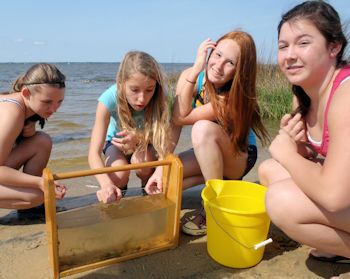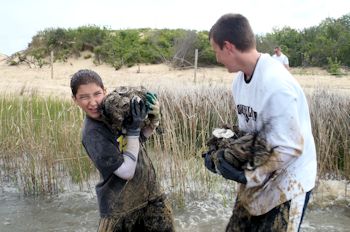 Sara Hallas, center, works with students at First Flight Middle School. Sara Hallas, center, works with students at First Flight Middle School. |
MANTEO – School kids in nearby Kill Devil Hills will have more opportunities to get outside and learn about the coastal environment thanks to a $5,000 federal grant that the N.C. Coastal Federation recently received.
The federation received one of the 18 grants in the Southeast that are designed to teach kids about the watersheds where they live by taking them out on field trips and having them take part in a service project. Teacher training is also a grant requirement.
Supporter Spotlight
The U.S. Environmental Protection Agency provides the money, which is distributed by the Florida Office of Environmental Education. Five thousand dollars is the most an applicant can receive.
The federation will use the money to organize two trips to Jockey’s Ridge State Park this school year for eighth-grade students at First Flight Middle School in Kill Devil Hills, instead of just the annual spring trip the federation had been implementing.
“This is my sixth year working with the school,” said Sara Hallas, a coastal education coordinator for the federation.
The real-life examples and hands-on activities at Jockey’s Ridge during the annual trip help students understand their science vocabulary, instead of memorizing it and moving on, she noted.
“They really appreciate when an outside instructor will reinforce some of the same things they’ve been learning,” she said.
Supporter Spotlight
The grant funding will benefit 200 eighth-grade students and three science teachers.
The plan is to use the shoreline restoration project at Jockey’s Ridge as an outdoor classroom, “so they can see the plants and animals that are in this habitat and apply their knowledge that they’ve learned in the classroom.”
Hallas envisions students visiting the site in the fall and spring, collecting information and comparing it between the seasons.
 |
 The shoreline restoration project at Jockey’s Ridge State Park has been a wonderful outdoor classroom for local students. The shoreline restoration project at Jockey’s Ridge State Park has been a wonderful outdoor classroom for local students. |
Students will learn about watersheds, coastal habitats and how the shape of the dune changes based on the dominant wind directions in the seasons. They will perform water quality testing, plant and animal identification, fish catch and release and some identification of animal tracks, she said.
The three teachers attended a professional environmental training workshop given by the federation this week, where they “learned more ways to incorporate these environmental lessons into their regular lessons throughout the school year,” Hallas said.
“We can’t wait,” said Liz Gray, one of the science teachers, said before the workshop.
The completed shoreline restoration project at the park itself was made possible through grants.
Pictures since 2008 when students started on the oyster reef work show a change that is “pretty dramatic for everyone that sees it,” Gray said, adding that the pictures are shown each year to the students.
“Some kids haven’t even been to Jockey’s Ridge before even though they live here,” Gray added.
“It was also interesting to see after Hurricane Irene hit in 2011 how that section really took a hit, but it would have been a lot worse if that oyster reef was not there,” Gray said.
“It’s always a good animal show when we go,” she continued. “When they see the living creatures they can get their hands on, from plankton all the way up to small fish, it helps motivate them.”
Interacting with the local fauna also helps them understand why the habitat is important; and the oyster reef calms the energy of the sound’s waves in a noticeable way, Gray added.
Last year, students learned how to distinguish grasses from bushes, as well as some parameters to judge if a body of water is healthy, she said.
“I’m very glad to have this supplemental funding to help us continue this program,” Hallas said.
“It’s pretty expensive to take the students anywhere just because of the sheer numbers of students,” Gray noted.
Hallas plans for students to contribute to the maintenance of the living shoreline by collecting marsh grass seeds during the fall trip, slated for Nov. 13, and grow the seeds in the classroom over the winter.
During the spring trip, they could plant “their new grasses that hopefully they grow successfully, adding to the project itself,” she said.







